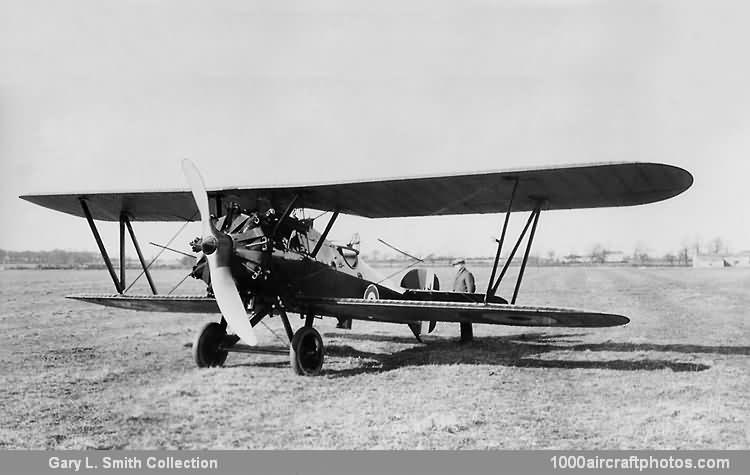Six weeks later the war ended and all production contracts were terminated, but experimental contracts were kept in being and the first two Badgers were completed. The first suffered engine failure from an airlock in the fuel system on its first take off on February 4, 1919, and Chief Test Pilot Cyril F. Uwins made a crash landing in which the landing gear and engine mounting were destroyed. It was repaired with a more pointed cowling and a larger rudder, and delivered to the Air ministry on February 15, 1919. The second Badger was flown without armament, with the rear cockpit partly enclosed, on May 24, 1919.
In the early flight tests, lateral control of the Badger was not satisfactory and so the third prototype was cancelled before delivery. The second Badger was formally purchased by the Air Ministry on September 5, after having had a Dragonfly engine substituted for the Jupiter, with full armament and equipment installed; a fixed fin, added to improve handling with the heavier Jupiter engine and airscrew, was retained.
When the Badger had been designed and before construction was completed, Barnwell and Leslie G. Frise had designed a simple rectangular fuselage of spruce and plywood in which was installed a 240 hp Siddeley Puma six-cylinder liquid-cooled in-line engine. To this were attached a spare set of Badger wings, tail surfaces and landing gear. Known at first as the Type 23X Badger Experimental (the name was soon shortened to Badger X), this machine was the first Bristol aircraft to be entered on the British Civil Register as K-110 c/n 5658, which was revised to G-EABU on May 30, 1919.
By that date it had already been written off, for, although Uwins made a successful first flight on May 13, Barnwell himself nosed it over on May 22 and had to be released by onlookers from the safety harness in which he hung helpless upside down. He was uninjured and the aircraft was not beyond economic repair, but the Directors decided not to go to the expense of doing so in a machine which could not easily be developed into a commercial two-seater. Barnwell himself had hoped to use the Badger X as a runabout and it was nicknamed "Barnwell's Week-ender".
The Air Ministry was sufficiently impressed with the Jupiter's performance to order a fourth Badger equipped to full military standard. This was designated Type 23A Badger Mk.II, s/n J6492 c/n 5657. As at first built it had the same rudder as F3496, but this was replaced by a horn-balanced unit in conjunction with redesigned wings featuring large-area ailerons with 'park-bench' balances designed by Frise. Unknown to him, an exactly similar device had just been patented by Avro, who wrote to Bristol pointing out the infringement; the matter was settled amicably and Frise then sought an alternative method of aerodynamic balancing, which later became world-famous as the Frise aileron, for which royalties were paid for fifteen years by many other manufacturers, including Avro.
The Badger Mk.II was formally purchased by the Air Ministry on March 11, 1920 and loaned to Bristol thereafter for development testing of the Jupiter engine, of which Bristol acquired the whole design and manufacturing organization in July 1920. Several different engine cowlings were tested on the Badger Mk.II, the last being a polygonal type designed for the Handley Page O/10 installation in July 1921."
|
|
Badger |
Badger Mk.II |
Badger X |
